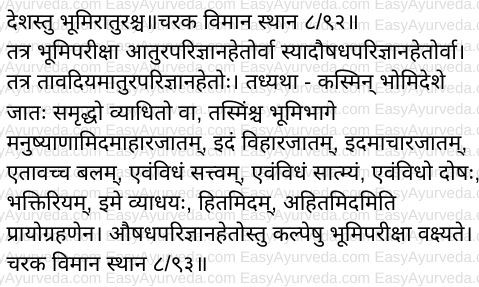Examination of Desha: Habitat / Human Body
Dr Raghuram Y.S. MD (Ay) & Dr Manasa, B.A.M.S
Desha means habitat. Desha in terms of treatment is the ‘human body’. Therefore examination of desha (Desha Pariksha) includes examination of habitat and various aspects of human body. Both would yield useful information related to treatment of diseases and diseased.

Table of Contents
Meaning of Desha
Desha means place or habitat. Desha comprises of land (habitat) and the body of the patient.
Desha pariksha is the 7th factor to be examined as per Master Charaka’s ten factors to be examined i.e. dasha vidha parikshya bhavas. This has been divided into –
- Examination of the land / soil – Different geographical habitats wherein people live has been explained along with the impact of land and plants / medicines / foods grown therein on doshas and health of individuals born and brought up in that habitat
- Examination of human body – In these once again 10 factors to be examined in human body has been explained. It is called as Dashavidha Pariksha or tenfold examination. This is a very important aspect of clinical examination. Documentation of these 10 factors in relation to the patient’s history is very essential for comprehensively treating the patient and for clinical success. It is also the popular pariksha vidhi i.e. mode of examination of the patient.
Read – 10 Factors Of Patient Examination – Dasha Vidha Atura Pareeksha
Importance of knowing the habitat
1. Land or geography of the person as habitat – Both these aspects of desha have to be examined. Examination of land would give us an idea of the impact of geography on the health of individuals. This is because people living in particular habitat would be influenced by food, medicine, living conditions and lifestyle of that particular habitat. They may be accustomed to their habitat as a part of adaptation and practice and being part of clan which has lived in that part of land for many years. This would also provide genetic tolerance to that land.
As a rule, the habitat or the foods and other components of that habitat should not cause any intolerance or disturbance of health in these individuals. But extremes will definitely have some affect. Knowing the geography of an individual will help the physician to help people in making changes in their diet, lifestyle and attitude, which is the most essential part of treatment.
This will especially come into account for people changing their habitat or migrate to other places. These people are susceptible for imbalances in health. This is because the foods, practices and lifestyle of that habitat and also the climatic changes.
If new place and new living conditions do affect an individual, the physician should be the right person to help them to live good therein. For this the physician should have a precise knowledge of habitat.
2. Human body as habitat – Human body also has been explained as a habitat by Master Charaka. There are many factors to be examined in the physical body of the patient. This is explained in the form of dashavidha pariksha i.e. tenfold patient examination. This is required for proper diagnosis of the disease, to analyze the strength, tolerance and endurance of the person and treat the given conditions comprehensively.
Read – Roga, Rogi Pareeksha: Examination Of Disease And Patient
Examination of desha
The location of diseases and for administration of medicines is called as desha.
1. Bhumi desha pareeksha – examination of habitat
The objective of examination of habitat are twofold. They are –
a. To obtain thorough knowledge of the patient in a particular habitat
For this the below mentioned aspects need to be examined –
- Place where the person born
- Place wherein the person is brought up
- Place living where the person has acquired the disease
- Food habits of people in that habitat
- Lifestyle and activities of people living in that habitat
- Conditions in which the people of that habitat live and adapt to
- Strength and endurance of people living in that habitat
- Mentality and attitude of people living in that habitat
- Compatibilities of people related to food, activities and living in that habitat
- Dosha imbalances which occur in that habitat
- Likes and dislikes of people living in that habitat
- Kinds of diseases which manifest in that habitat
- Good and bad things in and about the habitat
Apart from the above said factors any subtle things which come into the observance of the physician in relation to the patients living in a given habitat shall be thoroughly considered and examined.
b. To obtain thorough knowledge of the medicines grown in a given habitat
Examination of the medicines grown in a given habitat shall be done on the basis of explanation of the same given in the first chapter of Kalpasthana section of Charaka Samhita.
Read – Bala Samprapti: Understanding pathogenesis Based On Causes And Symptoms
2. Atura desha pariksha – examination of the patient (body and mind)
The land for treatment is the body of the patient. The objective of examination of patient are twofold. They are –
a. To obtain comprehensive knowledge of the quantity of lifespan (strength of association of body, mind, senses and soul) of the patient
b. To obtain comprehensive knowledge of the quantity of strength and dosha in the patient
This is a very important aspect of the patient examination since the dosage of the medicines depends on the quantity of vitiation of doshas. The dosage of medicines varies from disease to disease and in various stages of the disease. The medicine is also prescribed in specific dosages only after having considered the strength of the patient and disease.
If an unskilled physician suddenly administers very strong medicine to a patient having less strength and endurance, without even examining the patient and medicines – the medicine would prove lethal to the weak patient and will take away his life. This is because these patients cannot tolerate strong medicines. People having less strength will not tolerate strong medicines predominant in qualities of fire and air elements and will also not tolerate interventions like surgery, fire cauterization and alkali cauterization. Therefore the wise physician administer medicines which are mild in nature, and gradually increase the dosage and potency of the medicines as and when needed. He will take extra caution if the patient is a woman. This is because women have inconsistent mind, soft nature and would get scared by smallest discomfort due to their delicate nature.
The opposite is also true. When an ignorant physician implement medicines of lesser strength and potency to a strong patient suffering from a strong disease, the medicines would be wasted. Larger doses of strong medicines need to be administered in such diseases to get rid of them. Since the patients are also stronger in nature they would readily tolerate strong medicines and interventions. All these things should be analyzed and taken into consideration before starting the treatment.
Read – How Dose Of Ayurvedic Medicine Is Decided? 7 Factors
Sanskrit Verses

Dashavidha Pariksha – 10 fold examination of the patient
Ten fold examination of the patient helps in and aims at studying and understanding the quantity of strength in the patients.
They are as below mentioned –
a. Factors explained by Master Charaka
| Sl No | Factor to be examined | Meaning |
| 1 | Prakriti | Constitution of the person |
| 2 | Vikriti | Imbalances occurring in the constitution / pathology |
| 3 | Sara | Essence of the tissues |
| 4 | Samhanana | Compactness of the body and body parts |
| 5 | Pramana | Measurements of the body parts |
| 6 | Satmya | Habits and compatibility |
| 7 | Sattva | Mental strength |
| 8 | Ahara Shakti | Digestion capacity |
| 9 | Vyayama Shakti | Exercise tolerance |
| 10 | Vaya | Age |
b. Factors explained by Master Vagbhata
| Sl No | Factor to be examined | Meaning |
| 1 | Dushyam | Structural and functional abnormalities in the body |
| 2 | Desham | Geographical nature of the place where the patient lives |
| 3 | Balam | Physical strength of the patient |
| 4 | Kalam | Seasonal and climatic conditions |
| 5 | Anala | Digestive fire and its condition |
| 6 | Prakriti | Constitution of the patient |
| 7 | Vaya | Age of the patient |
| 8 | Sattva | Psychological nature of the patient |
| 9 | Satmya | General and personal habits of the clients, ability to adapt |
| 10 | Ahara | Nature of patient’s diet |
Read –Importance Of Diet (Pathya) For Specific Diseases
Desha from Research perspective
In the research study one of the important aspects to look at is ‘selection of study site’. The geographical distribution is considered for not only the selection of samples for the study but also to interpret the results of the study.
Ecological studies too can be considered as the study of location or desha. It is meant for exploring the statistical connection between diseases in different population groups. It is also used to explore the estimated exposures to a disease in groups rather than individuals.
A very useful tool that improves the ability of ecological studies is the ‘geographic information system. It helps the ecological studies to determine link between health data and a source of environmental exposure.
Click to Consult Dr Raghuram Y.S. MD (Ayu)









